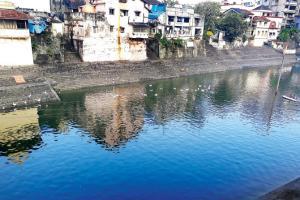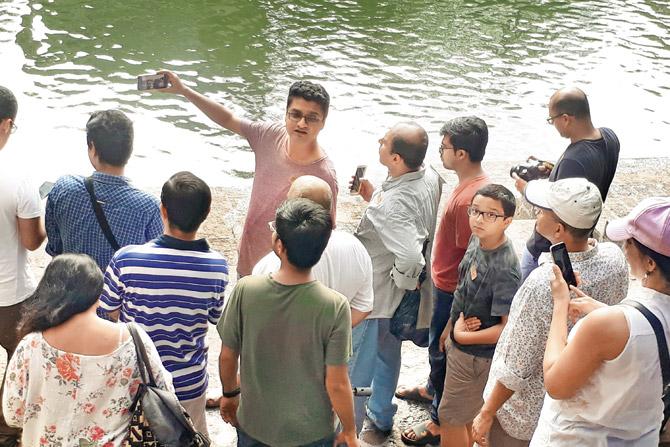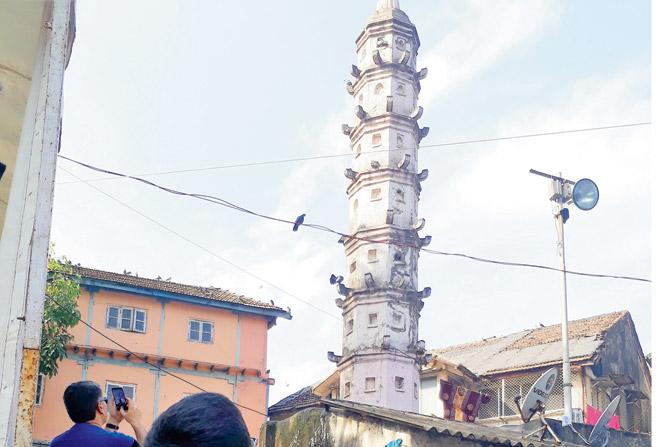Banganga, Walkeshwar (Outdoors)

The Banganga Tank in Walkeshwar was built in 1127 AD
Many many years ago, I saw a photograph of women sitting by stone steps as diyas floated in a waterbody. The photographer had caught the water glittering with the diyas, its reflection as well as of the women in their traditional finery. The image remained with me because the caption read Banganga, Mumbai. Since then, I have been dying to visit this area.
ADVERTISEMENT
And that is why, one early morning, I drag both my kids to participate in Khaki Tour's (KT) heritage walk at Banganga, Walkeshwar. When we reach, the group has already assembled at the meeting point of the Walkeshwar bus-depot and Bharat Gothoskar, founder of KT, is explaining what to expect from the two-hour long walk.

For those who don't know, Banganga is a massive water tank built in 1127 AD by Lakshman Prabhu, a Gaud Saraswat Brahmin minister in the court of the Silhara dynasty that ruled over Thane and the islands of Bombay from 810 to 1240 AD. Somewhere in the 16th century, the main temple by the tank was destroyed by the Portuguese who took over Bombay. And in 1715, another Gaud Saraswat Brahmin, a generous businessman, Rama Kamath, rebuilt it. The temple has been reconstructed many times and many smaller temples have come up around the tank.

The group is shown around this area as we do a parikrama of the space. Our first stopover is the shrine of Khandoba, the pastoral god of the Deccan plateau, who had wives from different castes including a Muslim one. We examine the dome while temple bells ring and devotees fling turmeric around the temple.
As we walk through the narrow undulating lanes of Banganga, the history of the place weaves its magic. As we reach the Jabareshwar Mahadev temple, we are informed of how by the 1860s more temples were built. Today, there are approximately 15 small temples in and around Banganga and around 32 mutts and dharamshalas.

The legend behind the water tank is that Ram, on his way to search for Sita, stopped here, fatigued and thirsty. When he asked Lakshmana to bring some water for him, he shot an arrow into the ground. Thus pierced by Lakshmana's baan, water gushed forth. The water, it is believed, is a tributary of the Ganga, which was summoned by the universe to quench Ram's thirst and thus the name Baanganga.
Gothoskar shares how the oldest inhabited settlement in Mumbai got the name Walkeshwar (valu, meaning sand; thus Walkeshwar was the Shiva which was made from sand). We are also told how the neighbouring Malabar Hill earned its name. Devotees from the south of Konkan would visit the area and in those days, anyone coming from the south was known as a Malabari. We enter the lane that eventually leads to the Raj Bhavan and we soak in as much as we can of the sweeping space.
We examine the domes of temples and learn about the history and influences of the place, while we inspect the Ram Kund, admire the lamp pillar that flanks the gateway of the tank and peer at the cenotaphs of Dashnami Goswami community that buries its dead in sitting samadhi position. That there are apartments built around these Samadhi-structures, seems to bother no one.

The tank itself is examined from many directions — the one we like best is atop a temple roof. (While descending we are delighted with the nemo-fish-like appearance of the statue of Hanuman that is a volcanic rock formation). There is a havan in progress on the steps of the tank, while ducks float around in the water and young men row barges inside the tank.
On our way out, we stop by for chai and to look at the home of Vishnu Narayan Bhatkhande, an Indian musicologist who wrote the first modern treatise on Hindustani classical music. This is a place to soak in, slowly. But it has been two hours, the sun is up and the kids are tired. We leave reluctantly.
Fact File
Where: Teen Batti, Malabar Hill.
Best for: Boys and girls eight years and above.
How to reach: Get off at Charni Road, and take a cab to Walkeshwar. Banganga is a landmark.
Timings: Monday to Thursday 12 noon to 9 pm. Friday to Sun 11.30 am to 9.30 pm
Budget: Free, unless you wish to conduct a ceremony or buy a snack. A guided tour is better. (Khaki Tours charges Rs 699 per head.)
Food: There are shops and restaurants nearby. But do carry snacks if your kids are fussy.
Water: Available to buy
Rest Room facilities: Public restroom
Where else to go: Kamala Nehru Park, Hanging Garden, Priyadarshani Park, Mani Bhavan and Royal Opera House
Parent Poll: Loved the narratives that were examined as we walked around. Will want to do it again.
Rating: 
Kids' Poll: Loved looking at the volcanic rock eruptions and were spooked-out-happy with the cenotaphs.
Rating: 
What's Good: Immersing oneself in history that comes alive through the walk.
What's Not So Good: Because the walk was not curated for kids, the content that was shared through the walk may not have been so interesting for the kids.
Catch up on all the latest Crime, National, International and Hatke news here. Also download the new mid- day Android and iOS apps to get latest updates
 Subscribe today by clicking the link and stay updated with the latest news!" Click here!
Subscribe today by clicking the link and stay updated with the latest news!" Click here!






